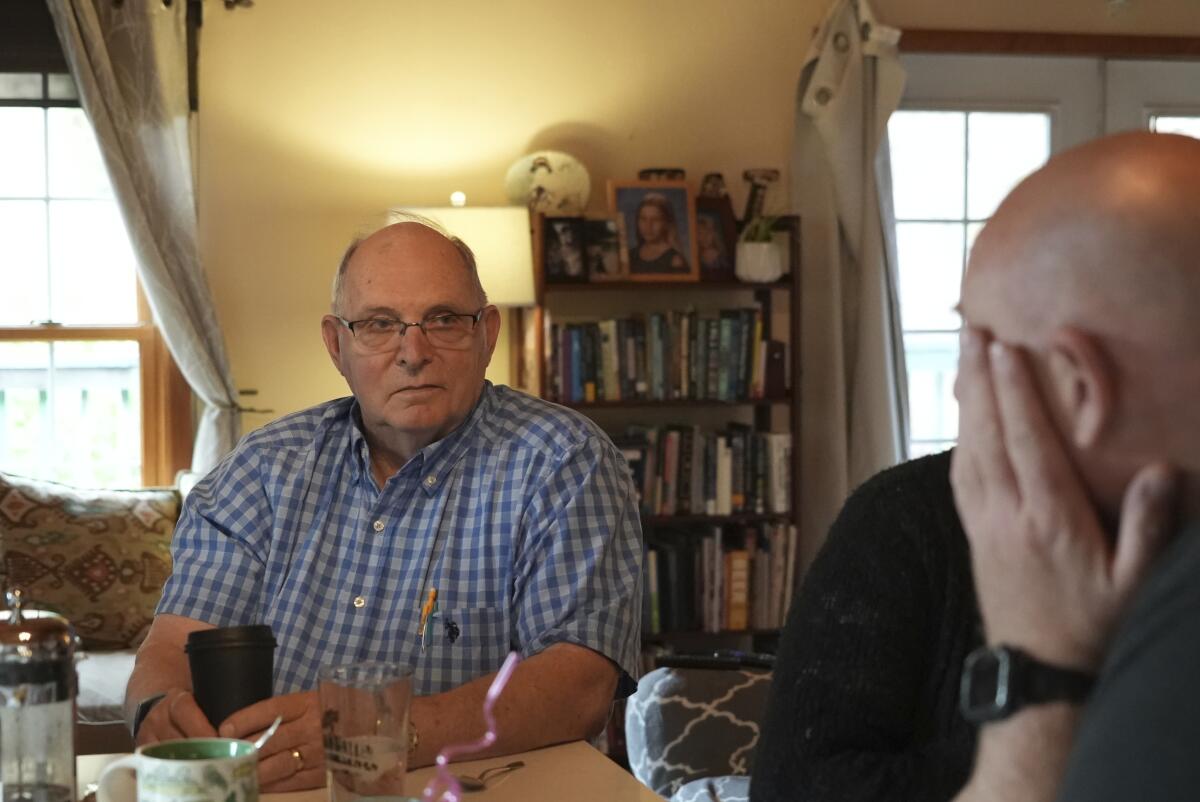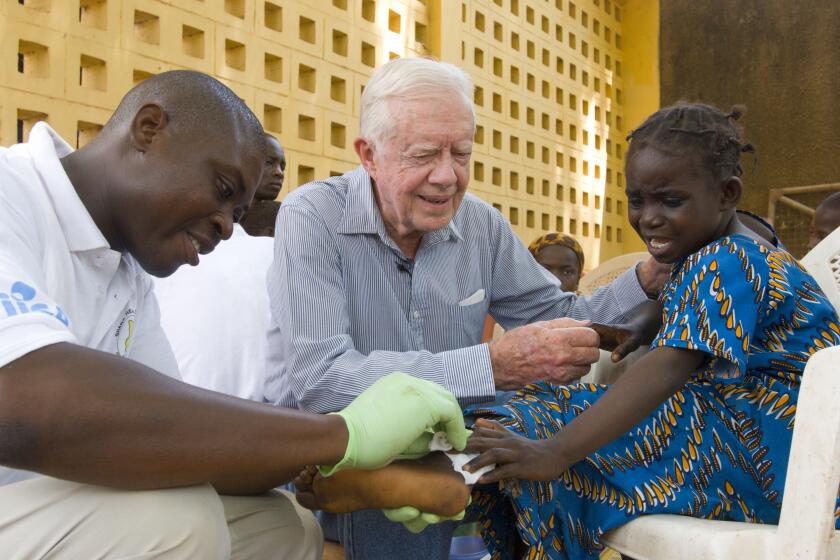Alzheimer’s escapees: Seeking clues from the few who avoid their genetic fate

- Share via
ST. LOUIS — Doug Whitney inherited the same gene mutation that gave Alzheimer’s disease to his mother, brother and generations of other relatives by the unusually young age of 50.
Yet he’s a healthy 73, his mind still sharp. Somehow, the Washington state man escaped his genetic fate.
So did a woman in Colombia who dodged her family’s similar Alzheimer’s destiny for nearly three decades.
To scientists, these rare “escapees” didn’t just get lucky. They offer an unprecedented opportunity to learn how the body may naturally resist Alzheimer’s.
“It’s unique individuals oftentimes that really provide us with breakthroughs,” said Dr. Eric McDade of Washington University in St. Louis, where Whitney’s DNA is being scoured for answers.
The hope: If researchers could uncover and mimic whatever protects these escapees, they might develop better treatments — even preventive therapies — not only for families plagued by inherited Alzheimer’s but also for everyone.
“We are just learning about this approach to the disease,” said neuropsychologist Yakeel Quiroz of Massachusetts General Hospital, who helped study the Colombian woman. “One person can actually change the world — as in her case, how much we have learned from her.”
Quiroz’s team has a pretty good idea what protected Aliria Piedrahita de Villegas: an additional genetic oddity that apparently countered the damage from her family Alzheimer’s mutation. But testing showed Whitney doesn’t have that protective factor, so something else must be shielding his brain.
Now scientists are on the lookout for even more Alzheimer’s escapees: people who may have simply assumed they didn’t inherit their family’s mutation because they’re healthy long after the age their loved ones always get sick.
One of former President Carter’s biggest hopes is wiping out an infectious parasitic disease that’s plagued humans for millennia. How close is he?
“They just think it’s kind of luck of the draw, and it may in fact be that they’re resilient,” said McDade, a researcher with a Washington University network that tracks about 600 members of affected families, including Whitney.
“I guess that made me pretty special. And they started poking and prodding and doing extra testing on me,” the Port Orchard, Wash., man said. “I told them, you know, I’m here for whatever you need.”
Answers can’t come quickly enough for Whitney’s son Brian, who also inherited the devastating family gene. He’s reached the fateful age of 50 without symptoms but knows that’s no guarantee.
“I liken my genetics to being a murder mystery,” said Brian Whitney, who volunteers for Washington University studies that include testing an experimental preventive drug. “Our literal bodies of evidence are what they need to crack the case.”
A disease affecting millions
More than 6 million Americans, and an estimated 55 million people worldwide, have Alzheimer’s. Simply getting older is the main risk; it’s usually a disease of people 65 and older.
Fewer than 1% of Alzheimer’s cases are caused by inheriting a single copy of a particular mutated gene. Children of an affected parent have a 50-50 chance of inheriting the family Alzheimer’s gene. If they do, they’re almost guaranteed to get sick at about the same age as their parent did.
That near-certainty enables scientists to study these families and learn crucial information about how Alzheimer’s forms. It’s now clear that silent changes occur in the brain at least two decades before the first symptoms — a potential window to intervene. Among the culprits, sticky amyloid starts building up, followed by neuron-killing tau tangles.
What happens instead in the brains of the resilient?
“That’s why I’m here,” said Doug Whitney, who for years has given samples of blood and spinal fluid and undergone brain scans and cognitive exams in the hunt for clues. “It’s so important that people in my situation come forward.”
Changes wrought by the COVID-19 pandemic have upended the lives of millions of dementia patients and their caregivers, who rely on long-standing routines.
Whitney’s grandparents had 14 children; 10 of them developed early-onset Alzheimer’s. The first red flag for his mother: Thanksgiving 1971, when she forgot the pumpkin pie recipe she’d always made from memory.
“Five years later she was gone,” Whitney said.
Back then doctors didn’t know much about Alzheimer’s. It wasn’t until the 1990s that separate research teams proved three genes, when mutated, can each cause this uniquely inherited form of the disease. They each speed abnormal amyloid buildup.
Whitney’s family could only watch and worry as his 50th birthday came and went. His older brother had started showing symptoms at 48. (Some other siblings later were tested and didn’t inherit the gene, and two still don’t know.)
“We went through about 10 years when the kids would call home their first question was, ‘How’s Dad?’” his wife, Ione, recalled. “By the time he turned 60, we kind of went, wow, we beat the coin toss.”
But not the way he’d hoped. In 2010, urged by a cousin, Whitney joined the St. Louis research. He also agreed to a genetic test he’d expected to provide final reassurance that his children wouldn’t face the same worry — only to learn he’d inherited the family mutation after all.
“He kind of got leveled by that result,” Brian Whitney said.
Although Brian inherited the family gene, his sister Karen didn’t — but she too is part of the same study, in the healthy comparison group.
On the trail of answers
U.S. researchers aren’t the only ones on the trail of answers. In South America, scientists are tracking a huge extended family in Colombia that shares a similar Alzheimer’s-causing variant. Carriers of this mutated gene start showing memory problems in their early 40s.
In contrast, one family member, Piedrahita de Villegas, was deemed to have “extreme resistance,” with no cognitive symptoms until her 70s. Researchers flew the woman to Quiroz’s lab in Boston for brain scans. And when she died at 77 of melanoma with only mild signs of dementia, her brain was donated to Colombia’s University of Antioquia for closer examination.
Her brain was jam-packed with Alzheimer’s trademark amyloid plaques. But researchers found very little tau, and weirdly it wasn’t in the brain’s memory hub but in a different region.
You found her reading glasses in the fridge, saw bewilderment overtake him in the grocery store, heard from a concerned friend that something didn’t seem quite right.
Clearly something affected how tau formed and where. “The thing that we don’t know for sure is why,” Quiroz said.
DNA offered a suspect: an ultra-rare mutation on an unrelated gene.
That APOE gene comes in different varieties, including a version notorious for raising people’s risk of traditional old-age Alzheimer’s and another that’s linked to lower risk. Normally the APOE3 version that Piedrahita de Villegas carried makes no difference for dementia.
But remarkably, both copies of her APOE3 gene were altered by the rare “Christchurch” mutation, and researchers think that blocked toxic tau.
To start proving it, Quiroz’s team used preserved cells from Piedrahita de Villegas and another Colombian patient to grow some cerebral tissue in lab dishes. Cells given the Christchurch mutation developed less tau.
“We still have more work to do, but we’re getting closer to understanding the mechanism,” Quiroz said.
That research already has implications for a field that’s long considered fighting amyloid the key step to treating Alzheimer’s.
Instead, maybe “we just need to block what’s downstream of it,” said Dr. Richard Hodes, director of the National Institute on Aging.
And because Whitney, the Washington man, doesn’t have that extra mutation, “there may be multiple pathways for escape,” Hodes said.
In St. Louis, researchers are checking out another clue: Maybe something special about Whitney’s immune system is protecting his brain.
The findings also are fueling a search for more escapees to compare. The Washington University team recently began studying one who’s unrelated to Whitney. In Colombia, Quiroz said researchers are looking into a few more escapees.
Fueling the search
That search for answers isn’t just work for scientists. Brian Whitney estimates he spends about 25 days a year undergoing health checks and procedures, many of them far from his Manson, Wash., home, as part of Alzheimer’s research.
That includes every two weeks getting hooked up to a pump that administers an experimental amyloid-fighting drug. He also gets regular brain scans to check for side effects.
Living with the uncertainty is tough, and he sometimes has nightmares about Alzheimer’s. He tries to follow what he now knows was his parents’ mantra: “Make the best of life till 50 and anything after that is a bonus.”
He makes lots of time to go fishing and camping with daughter Emily, 12, who hasn’t yet been told about the family gene. He hopes there will be some answers by the time she’s an adult and can consider testing.
“When I have a bad day and decide maybe I should not continue [the research], I think of her and then that all vanishes,” he said.
More to Read
Sign up for Essential California
The most important California stories and recommendations in your inbox every morning.
You may occasionally receive promotional content from the Los Angeles Times.














